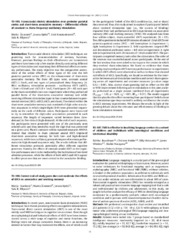Prikaz osnovnih podataka o dokumentu
Correct end-of-study guess does not moderate the effects of tDCS on associative and working memory
| dc.creator | Stanković, Marija | |
| dc.creator | Živanović, Marko | |
| dc.creator | Bjekić, Jovana | |
| dc.creator | Filipović, Saša R. | |
| dc.date.accessioned | 2023-09-21T13:30:35Z | |
| dc.date.available | 2023-09-21T13:30:35Z | |
| dc.date.issued | 2022 | |
| dc.identifier.issn | 1388-2457 | |
| dc.identifier.uri | http://reff.f.bg.ac.rs/handle/123456789/4858 | |
| dc.description.abstract | In recent years, non-invasive brain stimulation (NIBS) techniques have shown promising effects on cognitive enhancement. Transcranial direct current stimulation (tDCS) is one of the most widely used NIBS techniques in cognitive neuroscience. Even though the neurophysiological and behavioral effects of tDCS have been demonstrated across a wide range of cognitive and motor functions, the findings were not always consistent. Hence, there is an increasing interest in factors that may moderate the effects, one of which could be the participants’ beliefs of the tDCS condition (i.e., real or sham) they received. Thus, this study aimed to explore if participants’ beliefs about received stimulation type (i.e., the success of blinding) impacted their task performance in tDCS experiments on associative memory (AM) and working memory (WM). We analyzed data from four within-subject, sham-controlled tDCS experiments (N = 83). Two AM experiments included 20 minutes of anodal 1.5mA tDCS over the posterior-parietal cortex (PPC) – left hemisphere in Experiment 1; right hemisphere in Experiment 2. WM experiments targeted PPC and dorsolateral prefrontal cortex – left side in Experiment 3; right side in Experiment 4, with 20 minutes of 1.8mA anodal tDCS. The participants completed memory tasks after the stimulation. The order of the sessions was counterbalanced across participants. At the end of the last session, they were asked to try to guess the session in which they received sham stimulation. We found no evidence that sham guessing moderated post-tDCS memory performance in experiments in which tDCS effects were observed as well as in those that showed null effects of tDCS. Specifically, we found no evidence for the interaction between actual stimulation condition and correct sham-guessing across all experiments and outcome measures (p-values range 0.12 – 0.99). Also, correct sham-guessing had no effect on the AM or WM improvement following active stimulation in the joint analysis performed on a single dataset combined from all experiments (F(1,248) = 1.61, p = 0.21, partial eta squared = 0.01, BF10 = 0.31). The results suggest that the placebo-like effect stemming from participants’ beliefs about the stimulation type they received is unlikely to influence the results in tDCS memory experiments. We discuss the results in light of the growing debate about the relevance and effectiveness of blinding in brain stimulation research. | sr |
| dc.language.iso | en | sr |
| dc.relation | info:eu-repo/grantAgreement/EC/HE/CSA/101059369/EU// | sr |
| dc.relation | info:eu-repo/grantAgreement/MESTD/inst-2020/200015/RS// | sr |
| dc.relation | info:eu-repo/grantAgreement/MESTD/inst-2020/200163/RS// | sr |
| dc.rights | openAccess | sr |
| dc.rights.uri | https://creativecommons.org/licenses/by/4.0/ | |
| dc.source | Clinical Neurophysiology | sr |
| dc.subject | transcranial direct current stimulation (tdcs) | sr |
| dc.subject | blinding | sr |
| dc.subject | sham-guessing | sr |
| dc.subject | placebo effect | sr |
| dc.subject | associative memory | sr |
| dc.subject | working memory | sr |
| dc.title | Correct end-of-study guess does not moderate the effects of tDCS on associative and working memory | sr |
| dc.type | conferenceObject | sr |
| dc.rights.license | BY | sr |
| dc.citation.spage | S3 | |
| dc.citation.volume | 141 | |
| dc.description.other | Abstracts of the 32nd International Congress of Clinical Neurophysiology (ICCN) of the IFCN, September 4-8, 2022, Geneva, Switzerland - Volume 141, Supplement, Pages SS1-S186 (September 2022) | |
| dc.identifier.doi | 10.1016/j.clinph.2022.07.010 | |
| dc.identifier.fulltext | http://reff.f.bg.ac.rs/bitstream/id/11872/TU105-6.pdf | |
| dc.type.version | publishedVersion | sr |

